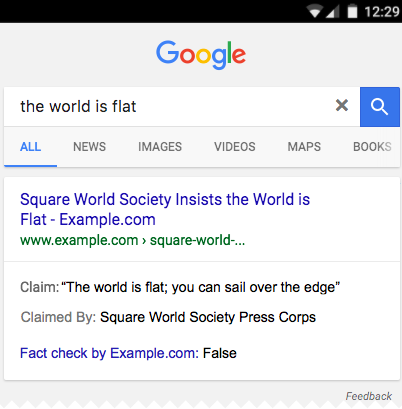Google rolled out a new feature Friday morning that will help fact checks stand out in search results.

Rendering courtesy Google – not an actual search result.
If a search query returns a result that includes a fact check, it will be featured as a snippet on the result page (see right).
The snippet will always include who said the claim and its accuracy rating. If a publication fact-checked more than one claim on the same topic, each fact check will be featured in a carousel.
The decision builds on Google’s decision in October to add a “Fact Check” tag in news results in a selected number of countries.
The initiative has been a joint project between Google and Jigsaw, a technology incubator overseen by Google parent Alphabet. The source tags have, in general, “been a hit” with users, said Justin Kosslyn, a product manager at Jigsaw. This has been true of the “Fact Check” tag too, a spokeswoman for Google said.
The Fact Check tag is an idea with a long history at Google, Kosslyn said. In a previous position at Google News in 2011, he started working on it but found that the necessary “building blocks” to make it work were missing.
It’s since become feasible thanks to the increase in fact-checking publications worldwide and technical building blocks like Schema.org, which Kosslyn says provided “an open internet metric for us to distinguish different pieces of content.” The Duke Reporters’ Lab also played a crucial role in supporting Google and Jigsaw conceptualize and deploy the tag.
Google’s latest search tweak fits into a broader push to add context to digital content that signals trustworthiness (or lack thereof). From media outlets more clearly identifying satire and opinion articles in headlines to Facebook’s partnership with third-party fact-checkers to flag disputed content, several attempted solutions to the problem of rampant misinformation fit this trend.
Which organizations qualify as reliable fact-checkers will inevitably become a point of contention. In order for an item to appear as a fact check on Google, its publisher must: be using the Schema.org ClaimReview markup or the Share the Facts widget; adhere to the Google News General Guidelines; be “algorithmically determined to be an authoritative source of information.”
Google is wary of sharing proprietary information on the final point, but Kosslyn compared it to the technology used to detect spam and said there are about 200 signals of quality that factor into the algorithm’s decision.
Google also defines fact checks in detail, something that many traditional media outlets have yet to do.
It is conceivable that search results will end up featuring fact checks with different ratings, or with a fact check appearing just above the debunked information.
On this point, in a blog post announcing the change, Kosslyn and Cong Yu of Google Research write: “We think it’s still helpful for people to understand the degree of consensus around a particular claim and have clear information on which sources agree.”
Google’s system for snippets has not always been foolproof, returning off-kilter responses to topics like the first African-American President of the United States or why fire trucks are red.
As with snippets, the fact check card will have a feedback link that allows users to indicate that they believe something is wrong — in this case that a fact-checker violates Google’s policies on what is a fact check.
The fact check cards could provide greater reach to this type of journalism worldwide. They may also result in an increase in traffic for fact-checking websites, if readers aren’t satisfied with the quick summary included in Google’s cards.
The frequency and relevance of these cards will depend in part on the capacity of understaffed fact-checking projects to dedicate resources to retroactively mark up the claims and conclusions on thousands of fact checks in their archives.







